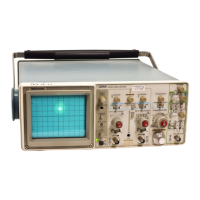Section 6—2215A Service
MAINTENANCE
This section of the manual contains information for conducting preventive maintenance, troubleshooting, and corrective
maintenance on the 2215A Oscilloscope.
STATIC-SENSITIVE COMPONENTS
The following precautions are applicable when perform
ing any maintenance involving internal access to the
instrument.
Static discharge can damage any semiconductor
component in this instrument.
This instrument contains electrical components that are
susceptible to damage from static discharge. Table 6-1 lists
the relative susceptibility of various classes of semiconduc
tors. Static voltages of 1 kV to 30 kV are common in unpro
tected environments.
When performing maintenance observe the following pre
cautions to avoid component damage:
1. Minimize handling of static-sensitive components.
2. Transport and store static-sensitive components or
assemblies in their original containers or on a metal rail.
Label any package that contains static-sensitive compo
nents or assemblies.
3. Discharge the static voltage from your body by wear
ing a grounded antistatic wrist strap while handling these
components. Servicing static-sensitive components or as
semblies should be performed only at a static-free work sta
tion by qualified service personnel.
4. Nothing capable of generating or holding a static
charge should be allowed on the work station surface.
5. Keep the component leads shorted together when
ever possible.
6. Pick up components by their bodies, never by their
leads.
Table 6-1
Susceptibility
to Static Discharge Damage
Semiconductor Classes
Relative
Susceptibility
Levels3
MOS or CMOS microcircuits or
discretes, or linear microcircuits
with MOS inputs. (Most Sensitive)
1
ECL
2
Schottky signal diodes 3
Schottky TTL
4
High-frequency bipolar transistors 5
JFETs
6
Linear microcircuits
7
Low-power Schottky TTL 8
TTL (Least Sensitive)
9
sVoltage equivalent for levels: (Voltage discharged from a
100 pF capacitor through a resistance of 100 Q.)
1 = 100 to 500 V 4 = 500 V 7 = 400 to 1000 V(est.)
2 = 200 to 500 V 5 = 400 to 600 V 8 = 900 V
3 = 250 V 6 = 600 to 800 V 9 = 1200 V
7. Do not slide the components over any surface.
8. Avoid handling components in areas that have a floor
or work-surface covering capable of generating a static
charge.
6-1

